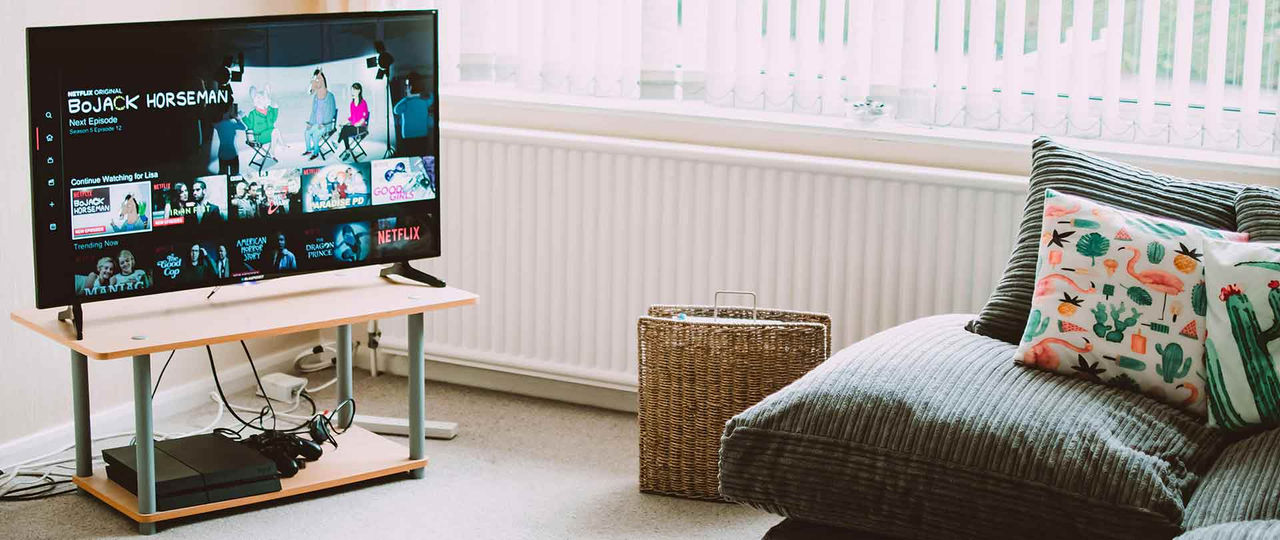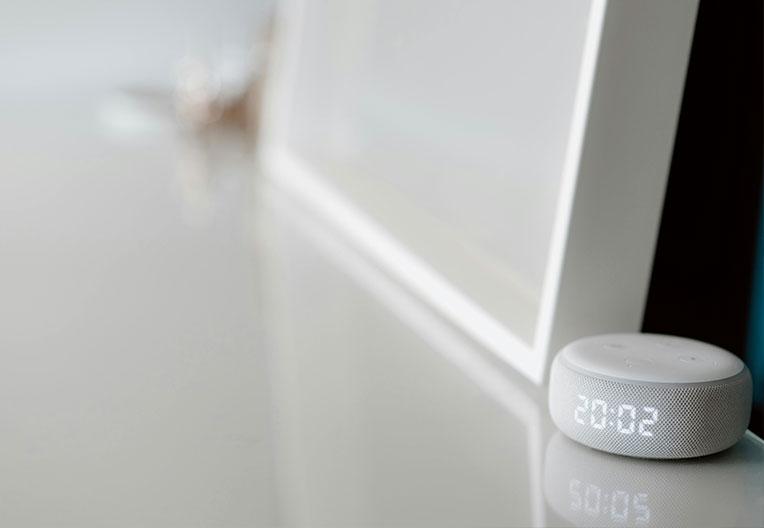
How to set up a smart home: the ultimate beginner’s guide
By Andy Snellgrove | Date published: 15th July 2024 | 12 min read
As digital technologies progress, more of us are trying to find ways to take advantage of them in our homes. Ease of living is a commodity. So it’s only natural that we’re now turning to tech to make the rigours of day-to-day life at home that little bit easier.
Artificial intelligence (AI) assistants, lights which know when to turn themselves on and off, or doorbells that show us exactly who’s knocking are just a handful of the innovative additions which can now be fitted in a home.
Households that rely on these kinds of upgrades are becoming increasingly popular. In fact, it’s estimated that by 2027 there will be as many as 15.1 million smart homes in the UK – representing a 50.2% market presence.
But what exactly are smart homes? And how can you set your property up to become one? In this informative guide, we’ll explore just that. From working out the best assistant for your home, to picking the technological upgrades to include, this guide should be your first port of call for designing your own.
What is a smart home?
A smart home is a convenient setup that allows residents to control different appliances and functions remotely, via the use of the internet. These interconnected devices can sometimes also be automatic, and will affect things like lighting, heating, home security, entertainment features, and energy efficiency.
Usually, a smart home can be accessed via one central point. This is usually an app that can be downloaded onto a device like a phone or tablet. It may also be that different elements of your home are controlled by a handful of apps.
For those looking for a one-app-fits-all approach, these multi-purpose smart home systems can either be wireless or hardwired into your property. If you’re trying to decide what kind of system you want to use, weigh up both options:
A wireless system
- Easier to install
- All-in-one approach is cost-friendly
- Some hardwired wireless access points and range extenders may be needed
- A good WiFi connection is required
- Usually a better option for smaller homes
A hardwired system
- Very reliable
- Difficult to hack
- Can be very expensive to install
- Ethernet cables are required
- Usually included in new builds as they’re easier to scale
Choosing your digital assistant and ecosystem
If you’ve made the decision to convert at least a part of your home, it’s important to have a digital ecosystem that pairs well with your devices. This means finding a virtual or digital assistant which will make widespread smart adaptations in your home seamless while ensuring instructions are followed in the most relevant way possible for your needs. Usually, the assistant will do this from a piece of hardware known as a hub.
There are three primary hub options available right now:
Google Home/Google Assistant. Ever at the forefront of all things innovative, Google Home is perhaps best known for the conversational and detailed nature of its voice assistant technology. While being compatible with a series of third-party apps, those with one or a handful of Android devices would be smart to pair them with the built-in Google Inc. tech.
Apple HomeKit. While perfect for iPhone users and those with Apple Watches, the HomeKit isn’t ideal for those who aren’t fans of the autonomy which Apple holds over their products. That said, devices from some of the major smart home brands are still compatible, although you’ll struggle to find as many supported devices from smaller companies. Siri is generally also considered the least accurate of the three major voice assistive technologies.
Amazon Alexa. With no major ties to existing smart devices, Amazon Alexa serves as the perfect choice of system for those wanting to rely more heavily on a blend of third-party apps. Alexa definitely allows for the most cross-compatibility in this regard, although you will need to have the Alexa App open if you want to give instructions from your mobile device.
If you have a particular smart device in mind, be sure that it’s compatible with one of these digital ecosystems before making your choice.
Planning your smart home

The planning stage of a smart home renovation is arguably the most challenging – but also the most exciting. It’s at this stage you decide what elements of smart technology you want to utilise to make life that little bit easier.
Defining the purpose of your smart home
Your first step will be to clearly define your goals. Most smart homes provide benefits in four primary ways. What specific devices you choose to add to a home will depend greatly on which of these you want to focus on:
Safety and security. Smart devices can provide an additional layer of security that gives you peace of mind every time you leave the house. Whether it’s remote doorbell technology that monitors visitors, automatic locking and unlocking features, smoke and carbon monoxide detection, or just general surveillance, it’s never been easier to keep our homes protected.
Automation. As we continue to evolve as a global society, more focus than ever is being placed on the automation of certain tasks and roles. This is no truer than in the home, where factors like turning lights on and off, setting alarms, scheduling and reminding you of events, maintaining a comfortable room temperature, and even sprinkling your garden are all possible without your involvement.
Improved entertainment. Modern innovations make it possible for residents to pause what they’re watching in one room, and then pick up right where they left off in another. Algorithms provide you with shows or films you might enjoy based on your viewing history, while audio systems can be fine-tuned to keep you engaged in every room of the house.
Energy efficiency. Optimising our energy bills is more important than ever. A smart home allows you to automate your heating as efficiently as possible, turning it off or on once it reaches a certain temperature. The same is true of lighting, which can be turned off if motion sensors detect nobody is in the room.
Deciding what rooms to focus on
Once you know exactly what your priority is, it’s time to start thinking about how this will affect different rooms. Breaking it down by all the different parts of your house, think about what a smart renovation might look like.
Living room. This area of the home is likely to be where you spend the most time. There are a host of additions which can be made, such as sound bars, entertainment systems, lighting, climate control, and voice assistance.
Bedroom. Your sleeping area should always be a place of immense comfort. That’s why additions in this room should prioritise temperature. Furthermore, you can also think about using voice-activated alarms that only turn off when you tell them to.
Kitchen. Touch screens and touch sensors are one of the best optimisation choices for the kitchen. This is a part of the home where time management is usually a necessity, so finding any way to save minutes or seconds could make a huge difference.
Office. If you’re fortunate enough to have a home office, there are additions which can be made here too. Smart furniture that incorporates charging devices and USB ports is a popular option. Adjustable lighting is also a handy aspect of office life – particularly for those who find themselves staring at a screen regularly.
Bathroom. Water wastage can be negated with the help of smart showers and taps that turn off after a preset period of time. For those wanting to really embrace new-age tech, smart mirrors can provide you with built-in displays that provide news updates, outside temperatures, and a host of other useful information.
Accessibility requirements in your smart home
It could also be that you, an inhabitant, or someone who regularly visits the home has specific accessibility requirements. This is again something which can be taken into account during this planning stage, with key considerations being:
Voice control. These kinds of autonomous controls make it easier for those with physical disabilities to stay on top of household chores, as well as comfort levels. Alexa, Siri, Google Assistant or any other kind of virtual helper make hands-free management of the home easier than ever.
App integration. If someone struggles to stay on top of more than one thing at once, unifying household management through a single app or ecosystem could be the best way to go. This keeps everything in one place, making it simpler to manage on a day-to-day basis.
Guest access. If you have a visitor who has accessibility requirements, you can make it easier for them to manage their stay via a guest network connection. This allows them to access your main hub and make adjustments to suit their needs, without giving them total control of your wider network.
Different smart home additions and technology

With your end goal firmly in view, it’s time to start thinking about exactly what additions you might want to make to your home. At a time when technological advancements are becoming more mainstream than ever, there are plenty of amazing adaptations you can make to a home. Here are just some of the most popular:
Cameras (security). Safety in the home begins with vigilance. Security cameras make it easy to observe the goings on around your home from anywhere, with most video streams able to be viewed from a remote device. These can be wall-mounted units, or even included as part of your doorbell system.
Door locks (security). Automatic locking and unlocking tech makes it possible to secure your home in an instant. You’ll never have to worry about whether you locked the door or not again, with remote access able to do the job with a click of a button. Pairing this with an existing traditional key and lock can also be handy in the event that you lose or forget your keys somewhere.
Sensors (security and efficiency). Motion detection sensors are able to trigger alarms or lights outside your home if they pick up intruders. They’re also handy to use inside the house too, as they can be used to tell your smart system to turn off the lights or smart devices in any room where there’s inactivity.
Plugs and sockets (efficiency). Certain brands offer you the chance to take traditional pieces of furniture or storage and turn them into smart charging units. Plugs and outlets allow these appliances to not only charge up your smart devices, but also monitor energy usage and turn off when they reach a certain point.
Lighting (efficiency and comfort). You can set your lights to turn on at a specific time or in certain lighting, or have them controlled via motion detection. This heightens your overall level of comfort, as well as ensuring you don’t let excess energy go to waste.
Thermostats (efficiency and comfort). Room temperature control is a huge part of optimising your smart home experience. Smart thermostats are able to gauge the conditions in a room and keep them levelled throughout all hours of the day. You just need to set a fixed temperature that you want the room to stay at.
Blinds or curtains (comfort). Motion sensors or remote access curtains and blinds can close or open depending on the time of day or light levels. This helps to keep a room comfortable in the event of no smart thermostat, while also helping to regulate your sleep patterns with the use of natural sunlight.
Speakers and voice assistants (automation and comfort). If you have a smart ecosystem that relies on voice assistive technology, you’ll be able to control most of your home with spoken instructions. These devices mean you rarely have to manually input anything.
TVs (entertainment). Smart TVs offer a wide variety of handy entertainment features, such as letting you cast a video, get access to all your favourite streaming services, or even allow you to start a show or movie in one room and finish it in another.
Smoke detectors (security). While traditional smoke detectors do a good job, smart devices are able to pick up additional toxins in the air and at a more acute rate. The additional benefit here is that they can send push notifications to your devices, letting you know if high levels of smoke are detected at home even when you’re not there.
Pet devices (security and automation). We all love our pets and will do anything to make sure they’re happy and healthy. A series of devices now exist to make that task a little bit easier. Automatic feeding units are perfect for evenings when you’re out of the house. These can sometimes be fitted with cameras which allow you to monitor them.
Vacuums (automation). Robotic vacuums are able to read their environment and avoid obstacles, all while cleaning your home. Once the job is done they’ll dock themselves back up to their charging station.
Network considerations when designing a smart home
In order for your smart home to be optimised, you’ll need to make sure your network connection is able to handle it. When it comes to this, there are a handful of considerations that need to be made in order to ensure your existing WiFi is capable of handling all requirements:
The type of network connection you need. Most smart devices will need a traditional WiFi connection. It can also be the case that a hardwire ethernet cable works best. In very rare cases, additional radio wave frequencies might be needed to facilitate the use of a smart device.
The speed of your home internet. In order for your devices to work as efficiently as possible you’ll need quite a lot of bandwidth. While factors like voice command don’t require particularly fast upload or download speeds, they are a necessity for efficient video streaming, security camera optimisation, and even smart doorbells. Ensuring you have a strong connection like Full Fibre broadband (also known as FTTP) is one of the best ways to ensure your speeds are up to scratch.
The range of a smart home network. Most WiFi hubs have a predetermined range when it comes to how much coverage they provide. You’ll need to make sure yours is large enough to accommodate your entire home. If you’re fortunate enough to live in a bigger house, you may need more than one hub for maximum efficiency.
Any special hardware. WiFi extenders or power adapters are common additions to a smart home setup that help to keep things running smoothly. The smart hub itself is also likely to be a piece of hardware. Finding room for all of these is a consideration that needs to be made.
Your network security levels. Smart devices tend to collect personal data as part of their day-to-day operations. As such, you’ll want to make sure that you’re keeping this information as safe as possible. A good way to do that is with the use of a virtual private network (VPN). These hide your location, while also serving as a firewall that blocks spam and malware attacking your network.
Smart home FAQs
If you’d like to discover more about how to set up your smart home, you may still have further questions. Browse this section to find out more about converting your home for maximum efficiency and comfort.
Written by Andy Snellgrove
Andy is the Openreach FTTP Product Manager and brings a wealth of experience in the broadband industry. With a strong background in launching FTTC, GFast, and most recently FTTP, he has collaborated with leading telecommunications companies to develop cutting-edge broadband capabilities.
Dive into other blogs that help to demystify complex broadband technology terms

What is a good download and upload speed?
Get the lowdown on broadband speed essentials in our informative blog. Uncover the differences between download and upload speeds, and learn how to keep your connection running smoothly.

Heard of Wi-Fi calling but don’t know how it works?
Learn all about Wi-Fi calling, a feature that allows you to make phone calls over a Wi-Fi network instead of using your phone provider’s network.

A guide to the best broadband for gaming
Are you a gamer? Dive into our comprehensive guide to discover the best broadband options specifically tailored for gaming enthusiasts.



















